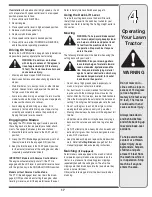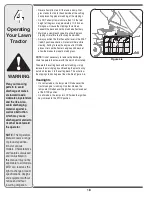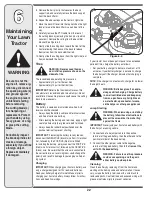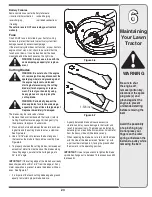
22
6
Maintaining
Your Lawn
Tractor
WARNING
Periodically inspect
the blade spindles for
cracks or damage,
especially if you strike
a foreign object.
Replace immediately
if damaged.
Be sure to shut the
engine off, remove ig-
nition key, disconnect
the spark plug wire(s)
and ground against
the engine to prevent
unintended starting
before removing
the cutting blade(s)
for sharpening or
replacement. Protect
your hands by using
heavy gloves or a rag
to grasp the cutting
blade.
5. Remove the hair pin clip that secures the deck
support rod, and carefully remove the deck support
from the deck lift arm.
6. Repeat the above steps on the tractor’s right side.
7. Move the deck lift lever into the top notch on the right
fender to raise the deck lift arms up and out of the
way.
8. Carefully remove the PTO cable from the rear of
the cutting deck by removing the hair pin clip which
secures it. Remove the spring from the deck idler
bracket. See Figure 6-5.
9. Gently slide the cutting deck toward the front of the
tractor allowing the hooks on the deck to release
themselves from the deck stabilizer rod.
10. Gently slide the cutting deck (from the right side) out
from underneath the tractor.
Tires
WARNING: Never exceed the maxi-
mum inflation pressure shown on the
sidewall of tire.
The recommended operating tire pressure is:
• Approximately 10 psi for the rear tires
• Approximately 14 psi for the front tires
IMPORTANT
: Refer to the tire sidewall for exact tire
manufacturer’s recommended or maximum psi. Do not
overinflate. Uneven tire pressure could cause the cutting
deck to mow unevenly.
Battery
The battery is sealed and is maintenance-free. Acid
levels cannot be checked.
• Always keep the battery cables and terminals clean
and free of corrosive build-up.
• After cleaning the battery and terminals, apply a light
coat of petroleum jelly or grease to both terminals.
• Always keep the rubber boot positioned over the
positive terminal to prevent shorting.
IMPORTANT
: If removing the battery for any reason,
disconnect the NEGATIVE (Black) wire from it’s terminal
first, followed by the POSITIVE (Red) wire. When
re-installing the battery, always connect the POSITIVE
(Red) wire its terminal first, followed by the NEGATIVE
(Black) wire. Be certain that the wires are connected to
the correct terminals; reversing them could change the
polarity and result in damage to your engine’s alternat-
ing system.
Charging
IMPORTANT:
When charging your tractor’s battery, use
only a charger designed for 12V lead-acid batteries.
Read your battery charger’s Owner’s Manual prior to
charging your tractor’s battery. Always follow its instruc-
tions and heed its warnings.
If your tractor has not been put into use for an extended
period of time, charge the battery as follows:
• Set your battery charger to deliver a maximum of 10
amperes. If your battery charger is automatic, charge
the battery until the charger indicates that charging is
complete.
NOTE:
If the charger is not automatic, charge for no fewer
than eight hours.
WARNING: Batteries give off an explo-
sive gas while charging. Charge battery
in a well ventilated area and keep away
from an open flame or pilot light as on
a water heater, space heater, furnace,
clothes dryer or other gas appliances.
Jump Starting
WARNING: When removing or installing
the battery, follow these instructions to
prevent the screwdriver from shorting
against the frame.
IMPORTANT
: Never jump your tractor’s dead battery with
the battery of a running vehicle.
1. Connect end of one jumper cable to the positive
terminal of the good battery, then the other end to the
positive terminal of the dead battery.
2. Connect the other jumper cable to the negative
terminal of the good battery, then to the
frame of the
unit with the dead battery.
WARNING: Failure to use this procedure
could cause sparking, and the gas in
either battery could explode.
Cleaning
Clean the battery by removing it from the tractor and
washing with a baking soda and water solution. If neces-
sary, scrape the battery terminals with a wire brush to
remove deposits. Coat terminals and exposed wiring with
grease or petroleum jelly to prevent corrosion.
Figure 6-5
















































